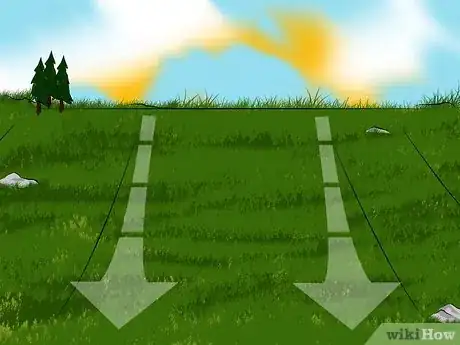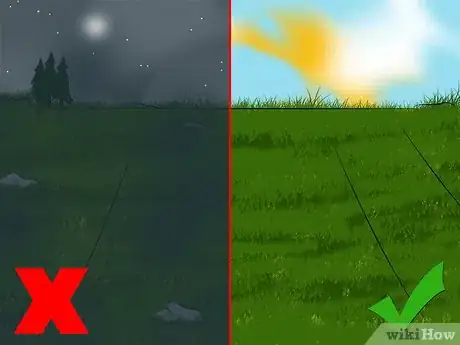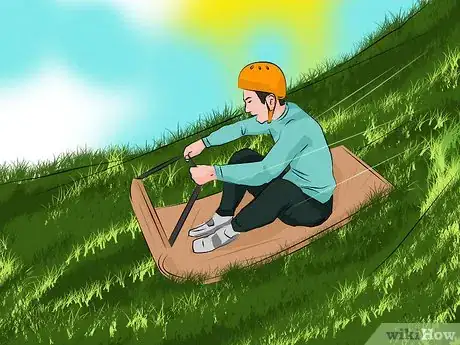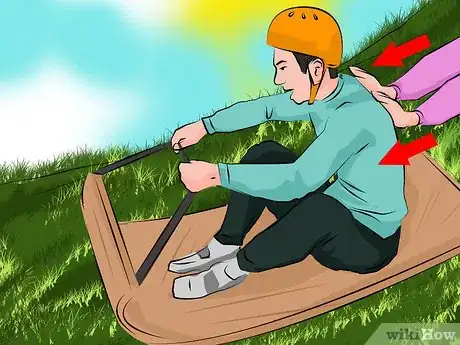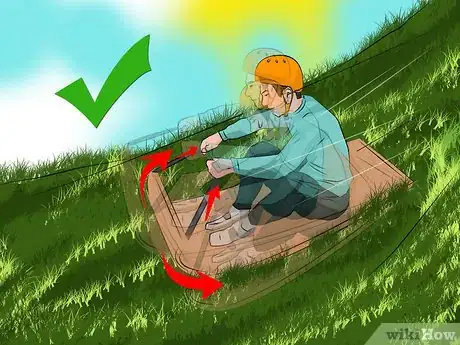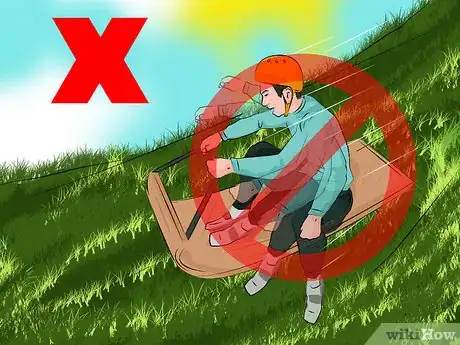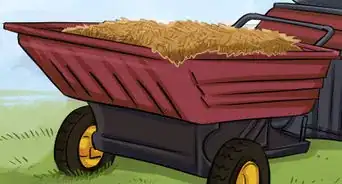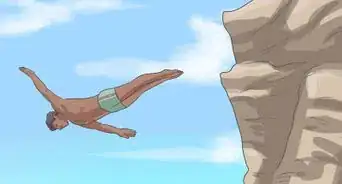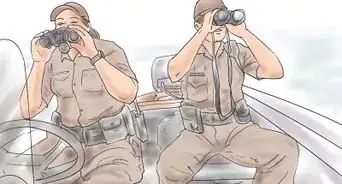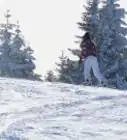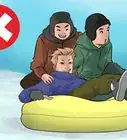This article was co-authored by wikiHow Staff. Our trained team of editors and researchers validate articles for accuracy and comprehensiveness. wikiHow's Content Management Team carefully monitors the work from our editorial staff to ensure that each article is backed by trusted research and meets our high quality standards.
This article has been viewed 61,830 times.
Learn more...
Sledding can be fun and exhilarating; the feeling of wind whipping through your hair while you slide down a snowy white hill is one of the most exciting and freeing feelings a person can have. But depending on where you live, or what time of year it is, there might not be any snow around. However, there is no need to miss out on the fun of sledding simply because it isn’t snowing outside. With a few simple steps and a little resourcefulness, you can keep sledding all year-round.
Steps
Finding the Right Location
-
1Look for a steep hill. A hill with a nice incline and an unobstructed area at the bottom is best.
- The hill should be inclined enough to easily slide down without needing to scoot yourself along, but not so steep that you might lose control and fall headfirst off of your sled.
- Avoid hills that end on a street or another major pathway. You’ll need a safe, open place to land and slow down at the bottom of the hill.
- It doesn’t matter whether the hill is made of dirt or if it’s covered in grass, just as long as it is steep enough to sled down.
-
2Check around for obstacles. Find a space that is open and free of any obstructions that will hurt you or hinder your sledding path.
- Avoid locations with lots of trees or wandering animals. It can be hard to slow down or quickly turn a moving sled, so choose a spot where you won’t risk ramming into a tree or cow while sledding.
Advertisement -
3Scope out an open space where no travelers are passing through. You want to avoid creating a risk to yourself and other people.
- Pay attention to the traffic in the area. If there are lots of runners, cyclists,or pedestrians around, you run the risk of sledding right into someone else.
- Stay away from any hills with dirt roads running through them. This means that there is probably a steady flow of traffic, and the area isn't safe for sledding.
Preparing to Sled
-
1Dress appropriately. Wear clothing that will protect you from injury and the elements.
- Always wear a helmet. It will keep your head safe in case you fall or run into something. Ski helmets and bike helmets work perfectly.[1]
- Wear jeans and long sleeves, no matter what time of year you’re sledding in. They will protect the skin on your arms and legs if you fall off of the sled, and will also help keep you warm if it’s cooler outside.
- If it’s cold outside, wear a hat, coat, and mittens.
- Do not wear scarves or anything that could possibly get caught in the sled and choke you.[2]
- If you have longer hair, pull it back so that you can see where you’re going at all times.
-
2Sled during the day. Being able to see around you while sledding will help prevent any injuries.
- Sledding in the dark makes it more difficult to see if an obstacle is coming your way or blocking your path.
- If you choose to sled at night, make sure the hillside area is lit very well.[3]
-
3Create a runway. Your hill needs to have a slippery pathway that is easy for your sled to slide down.
- If the hillside is grassy, you may not need to do anything. As long as the grass is alive and glossy and not crisp or dead, a sled will have an easier time sliding down the slope.
- A muddy hillside does not take any extra effort, since mud is naturally slippery.
- If the hill you choose is covered in dry dirt or dead, thin grass, you might need to create some mud by pouring water over the dry space. You can use a water hose if there is one close by, or bring along some buckets of water to pour down the hill.
- You can also create a runway by covering the hill with a long tarp, trash bags, palm leaves, or something similar.Use anything that is slick enough for a sled to easily glide down.
- Make sure the runway is as smooth as possible by removing potentially painful obstructions such as jutting rocks.
-
4Find a good sled. Anything large enough to sit on and grip, like a smooth garbage can lid or a manufactured sled without runners, will work.
- Look for something that is sturdy, thick, and safe. The sled should protect your behind while going down the hill.
- Do not use a sled that has runners. The runners are meant to cut through snow, and can be unsafe on regular ground.
- You can use a big plastic sledding saucer, or a toboggan (a sled without runners) with added steering.
- There are even some sleds made specifically for sledding on dry land if you don’t mind shelling out some money.
Sledding
-
1Be as safe as possible. It is important to practice safe behaviors when riding on your sled to prevent serious injury.
- Remain seated on your sled at all times. Staying seated will help you maintain control while you're riding down the hill. Never stand up, as the sled will likely slip out from under you and cause you to fall.
- Ride feet-first down the hill. Lying on your stomach while sledding downhill increases your risk of head injury. Sit with your behind on the sled, or lie back if necessary.[4]
- Surround yourself with friends. If you get hurt while sledding alone, it is important to have other people there to help you or to run for help if you can’t move.
-
2Prepare for a good start. Sit firmly on your sled and hold on tightly to the handle or sides.
- Brace yourself for your ride to the bottom. Hold on to any handles, reigns, or lips of the sled.
-
3Get a big shove from the top of the hill. Have a friend give you a strong push to get you started down the hill.
- Let a friend push you, rather than getting a running start on your own. It is safer to start out seated than to run and try to sit on the sled while it’s moving.
- For a little more speed, start several feet back from the top of the hill and have a friend push you while running forward.
-
4Slide down the hill. Hold on tightly the whole time and steer your sled if necessary.
- While sledding down the hill, keep your eyes open to avoid any dangers.
- Be sure to shift your bodyweight front, back, left, and right to keep yourself on a steady course and facing straight ahead.
-
5Land safely and slowly. Allow yourself to glide to a stop at the bottom of the hill.
- Don’t force yourself to stop unless you absolutely have to do so. Putting a leg, arm, or any body part out to stop yourself may result in you tumbling off of the sled, breaking a limb, or smashing into something.
- Slow down naturally and let your sled stop itself. Then you can run back uphill and do it again!
Community Q&A
-
QuestionHow do I stop myself?
 Undertale4141Top AnswererUse your feet; if you can't, roll off the sled. Your safety is more important than the sled's.
Undertale4141Top AnswererUse your feet; if you can't, roll off the sled. Your safety is more important than the sled's. -
QuestionHow do I go head first without hurting myself or maybe risking other people getting hurt on a big hill?
 Community AnswerJust make sure there is no one around. Also look out for trees, rocks, etc. Then go down. If you need to stop, try to put your feet on the ground. If you cant, roll off.
Community AnswerJust make sure there is no one around. Also look out for trees, rocks, etc. Then go down. If you need to stop, try to put your feet on the ground. If you cant, roll off.
Things You'll Need
- A steep hill with a smooth, slippery surface
- Garbage bags or tarp (optional)
- A garbage can lid or manufactured sled without runners
- Safety gear such as a helmet
- Water (optional)
Warnings
- Don’t let anyone pull you on the sled using a bike or car.⧼thumbs_response⧽
- Children should have parental supervision during sledding of any kind.⧼thumbs_response⧽
- Think safety! Only one person should be on a sled at a time, unless the sled is specifically labeled for multiple riders.⧼thumbs_response⧽
